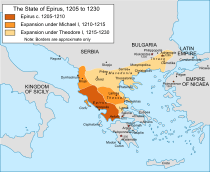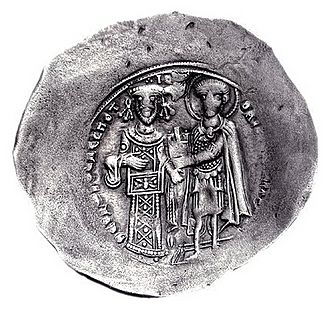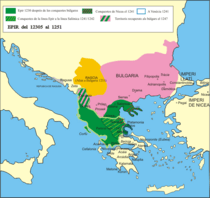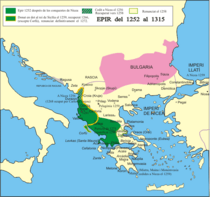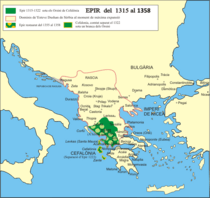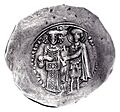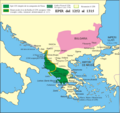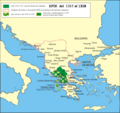Despotate of Epirus facts for kids
Quick facts for kids
Despotate of Epirus
|
|||||||||||
|---|---|---|---|---|---|---|---|---|---|---|---|
| 1204–1479 | |||||||||||
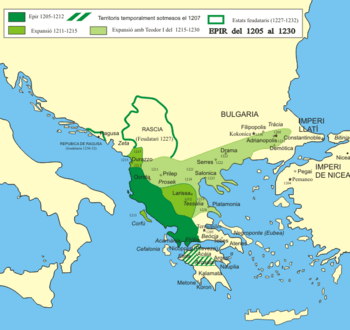
Despotate of Epirus in 1205 – 1230
|
|||||||||||
| Capital | Arta (1205–1337/40, 1430–49) Ioannina (1356–1430) Angelokastron (1449–60) Vonitsa (1460–1479) |
||||||||||
| Common languages | Greek | ||||||||||
| Religion | Greek Orthodoxy | ||||||||||
| Government | Absolute monarchy | ||||||||||
| Despot of Epirus | |||||||||||
|
• 1205–1214
|
Michael I Komnenos Doukas | ||||||||||
|
• 1448–1479
|
Leonardo III Tocco | ||||||||||
| Historical era | High Medieval | ||||||||||
|
• Established
|
1205 | ||||||||||
|
• Byzantine conquest
|
1337 | ||||||||||
|
• Re-establishment by Nikephoros II Orsini
|
1356 | ||||||||||
|
• Ottoman conquest of Vonitsa
|
1479 | ||||||||||
|
|||||||||||
| Today part of | Albania Greece |
||||||||||
The Despotate of Epirus (Medieval Greek: Δεσποτᾶτον τῆς Ἠπείρου) was a Greek state that formed after the Byzantine Empire broke apart in 1204. This happened because of the Fourth Crusade. It was one of several new states that claimed to be the true heir of the Byzantine Empire. The others were the Empire of Nicaea and the Empire of Trebizond.
The rulers of Epirus even called themselves Emperors for a short time between 1227 and 1242. During this period, it was often known as the Empire of Thessalonica. The name "Despotate of Epirus" is a modern term used by historians. It wasn't the official name used at the time.
This state was mainly located in the region of Epirus. It also included parts of Albania, western Greek Macedonia, Thessaly, and western Greece. Its territory reached as far south as Nafpaktos.
Under Theodore Komnenos Doukas, Epirus grew a lot. It briefly took over central Macedonia and Thrace. It almost recaptured Constantinople and brought back the Byzantine Empire. However, Theodore was defeated by the Bulgarian Empire in the Battle of Klokotnitsa in 1230.
After this defeat, the Epirote state became smaller. It mostly stayed in Epirus and Thessaly. It also had to become a vassal, meaning it was under the control of other powerful states. Epirus managed to stay mostly independent until the restored Byzantine Empire conquered it around 1337.
Later, in the 1410s, Carlo I Tocco managed to bring Epirus back together. But his family slowly lost control to the growing Ottoman Empire. The last part of Epirus, Vonitsa, fell to the Ottomans in 1479.
Contents
What Was the Despotate of Epirus?
The name "Despotate of Epirus" is how historians usually refer to this state. Its rulers are often called "Despots" from the very beginning. However, this isn't completely accurate.
The first ruler, Michael I Komnenos Doukas, never used the title "Despot." His successor, Theodore Komnenos Doukas, also didn't use it. Theodore actually crowned himself emperor around 1225. The first ruler of Epirus to be called "Despot" was Michael II Komnenos Doukas. He received this title from his uncle, Manuel Komnenos Doukas, in the 1230s.
The title "Despot" was a high rank in the Byzantine court. It was given by the emperor to close family members. It didn't mean someone ruled a specific area, and it wasn't passed down through families automatically. Over time, it became linked to certain regions like Epirus.
People at the time didn't have an official name for the Epirote state. In Western Europe, it was sometimes called Romania. This name usually referred to the whole Byzantine Empire. In the Byzantine world, Epirus was sometimes called Dysis, meaning "West." This was to show it was different from its rival, the Empire of Nicaea, which was called Anatolē or "East."
How Epirus Was Founded
The Epirote state was started in 1205 by Michael I Komnenos Doukas. He was a cousin of the Byzantine emperors Isaac II Angelos and Alexios III Angelos.
At first, Michael joined forces with Boniface of Montferrat. But after losing land to the Franks, he went to Epirus. There, he declared himself the Byzantine governor of the old province of Nicopolis. He then rebelled against Boniface.
Epirus quickly became a safe place for many people fleeing from Constantinople and other areas. Michael was seen as a hero, helping people escape the "Latin flood." The head of the Eastern Orthodox Church, the Patriarch, didn't see Michael as a true successor. So, Michael decided to recognize the authority of the Pope in Rome instead.
Henry of Flanders, the ruler of the Latin Empire, demanded that Michael obey him. Michael agreed, at least in name, by letting his daughter marry Henry's brother in 1209. But Michael didn't really stick to this alliance. He believed that the mountains of Epirus would protect him from any Latin attacks.
In 1210, Michael allied with the Venetians. He attacked Boniface's Kingdom of Thessalonica. The Pope punished him for this. Later that year, Henry forced Michael into another agreement.
Michael then focused on capturing important towns held by the Latins. These included Larissa and Dyrrhachium. He also took control of ports on the Gulf of Corinth. In 1214, he captured Corcyra from Venice. Michael was killed later that year. His half-brother, Theodore, took over.
Battles with Nicaea and Bulgaria
Theodore Komnenos Doukas immediately began to attack Thessalonica. He also fought with the Bulgarians along the way. Henry of Flanders died while trying to fight back. In 1217, Theodore captured Henry's successor, Peter II of Courtenay, and likely killed him.
The Latin Empire was busy dealing with the growing power of Nicaea. This meant they couldn't stop Theodore from capturing Thessalonica in 1224. Theodore then claimed the title of emperor for himself. He created the short-lived Empire of Thessalonica.
In 1225, John III Doukas Vatatzes of Nicaea took Adrianople. Theodore quickly took it back from him. Theodore also made an alliance with the Bulgarians. Together, they pushed the Latins out of Thrace. In 1227, Theodore crowned himself Byzantine emperor. However, most Greeks, especially the Patriarch in Nicaea, did not accept this.
In 1230, Theodore broke his peace agreement with Bulgaria. He wanted to remove Ivan Asen II, who had stopped him from attacking Constantinople. But in the Battle of Klokotnitsa, the Bulgarian emperor defeated Theodore. Theodore was captured and later blinded.
His brother, Manuel Komnenos Doukas, took power in Thessalonica. But Epirus soon broke away under Michael I's son, Michael II Komnenos Doukas. Manuel gave Michael the title of "Despot." This made Michael the first Epirote ruler to officially have this title. It showed he was supposedly dependent on Thessalonica, but Michael was actually independent. He showed this by taking Corfu around 1236.
Under Nicaean and Byzantine Rule
Thessalonica never regained its strength after the battle of Klokotnitsa. Theodore's younger son, Demetrios Angelos Doukas, lost Thessalonica to Nicaea in 1246. Michael II of Epirus then allied with the Latins against Nicaea. In 1248, John III Doukas Vatatzes of Nicaea forced Michael to accept him as emperor. In return, Vatatzes officially recognized Michael as "despotēs" in Epirus.
Vatatzes' granddaughter, Maria, later married Michael's son, Nikephoros I Komnenos Doukas, in 1256. Michael's daughter, Anna, also married William II Villehardouin, the Prince of Achaea, in 1248. Michael decided to honor this alliance over his duties to Vatatzes. The allies were defeated in the Battle of Pelagonia in 1259.
Emperor Theodore II Laskaris allied with Michael II. Their children, who had been promised to each other years before, finally married in 1256. Theodore received Dyrrhachium in return. Michael didn't like this transfer of land. In 1257, he rebelled and defeated a Nicaean army. As Michael marched on Thessalonica, he was attacked by King Manfred of Sicily. Manfred conquered Albania and Corcyra. However, Michael quickly allied with Manfred by marrying his daughter Helena to him.
After Theodore II died, Michael, and William II fought the new Nicaean emperor, Michael VIII Palaiologos. This alliance was very weak. In 1259, William was captured at the disastrous Battle of Pelagonia. Michael VIII then captured Michael II's capital of Arta. This left Epirus with only Ioannina and Vonitsa. Arta was taken back by 1260 while Michael VIII was busy fighting for Constantinople.
Italian Attacks
After Michael VIII restored the Byzantine Empire in Constantinople in 1261, he often bothered Epirus. He forced Michael's son, Nikephoros I Komnenos Doukas, to marry his niece, Anna Palaiologina Kantakouzene, in 1265. Michael VIII saw Epirus as a state under his control. However, Michael II and Nikephoros continued to ally with the Princes of Achaea and the Dukes of Athens.
In 1267, Charles of Anjou took Corcyra and much of Epirus. In 1267 or 1268, Michael II died. Michael VIII did not try to take Epirus directly. He allowed Nikephoros I to become ruler after his father. Nikephoros had to deal with Charles, who captured Dyrrhachium in 1271. In 1279, Nikephoros allied with Charles against Michael VIII. He agreed to become Charles's vassal. But after Charles's defeat, Nikephoros lost Albania to the Byzantines.
Under Andronikos II Palaiologos, Michael VIII's son, Nikephoros renewed his alliance with Constantinople. However, Nikephoros was convinced to ally with Charles II of Naples in 1292. Charles's fleet was defeated by Andronikos. Nikephoros married his daughter to Charles's son, Philip I of Taranto. He also sold much of his land to him.
After Nikephoros died around 1297, Byzantine influence grew. His widow, Anna, who was Andronikos's cousin, ruled as regent for her young son, Thomas I Komnenos Doukas. In 1306, she rebelled against Philip in favor of Andronikos. The Latin people were forced to leave, but she had to give back some land to Philip. In 1312, Philip gave up his claim to Epirus.
The Despotate Falls Apart
Anna managed to arrange for Thomas to marry a daughter of Michael IX. But Thomas was killed in 1318 by his cousin, Nicholas Orsini. Nicholas married Thomas's widow and claimed to rule all of Greece. However, his rule was limited to only the southern part of Epirus.
Nicholas was overthrown by his brother, John, in 1323. John tried to balance being under Constantinople's rule with working with the Angevins of Naples. The Angevins also claimed Greece as their territory. John was poisoned around 1335 by his wife, Anna. She then became regent for their son, Nikephoros II.
In 1337, the new Emperor, Andronikos III Palaiologos, arrived in northern Epirus with an army. Andronikos first dealt with problems caused by Albanian attacks. Then, he turned his attention to the Despotate. Anna tried to negotiate for her son to rule the Despotate when he grew up. But Andronikos demanded that the Despotate completely surrender. She finally agreed. This way, Epirus peacefully came under imperial rule. Theodore Synadenos became its governor.
The imperial family wanted Nikephoros to marry one of the daughters of the emperor's main helper, John VI Kantakouzenos. But when it was time for the engagement, Nikephoros had disappeared. Andronikos found out that Nikephoros had fled to Italy. Some Epirote nobles who wanted an independent Epirus helped him. He stayed in Taranto, Italy.
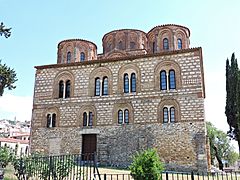
In 1339, a revolt began. It was supported by Catherine of Valois, who had moved to the Peloponnese. Nikephoros also returned to Epirus and joined the revolt. By the end of the year, the imperial army returned. In 1340, Andronikos III himself arrived with John Kantakouzenos. Nikephoros was convinced to accept the emperor's authority through talks. He surrendered his stronghold, married Maria Kantakouzene, and received a new title.
The Byzantine Empire soon fell into a civil war. Epirus was conquered by the Serbian tsar Stefan Dušan in 1348. Dušan appointed his brother, Simeon Nemanjić-Palailogos, as governor.
Nikephoros II took advantage of the Byzantine civil war and Dušan's death in 1355. He escaped and reestablished himself in Epirus in 1356. He also added Thessaly to his lands. Nikephoros was killed in battle in 1359 while trying to stop an Albanian revolt. The land of the former despotate became part of Simeon Nemanjić-Palailogos's personal empire. Simeon was also ruling Thessaly at the time. He left much of the territory to Albanian clans, who formed their own short-lived states.
In 1367, a part of the Epirote Despotate was brought back under a local Serbian nobleman, Thomas II Preljubović, who kept Ioannina. After Thomas died in 1384, his widow remarried in 1385. This transferred the Despotate to Italian nobles. The Serbian and Italian rulers of Ioannina continued the state's traditions. They asked the Ottoman Turks for help against the Albanians.
In 1399, the Albanian leader Gjon Zenebishi captured the Despot Esau de' Buondelmonti. He released him after 15 months when his relatives in Italy paid a large ransom. By 1416, the Tocco family from Cephalonia managed to reunite Epirus. They gained control over its towns. But disagreements within Epirus made it easier for the Ottomans to conquer it. Ioannina fell in 1430, Arta in 1449, Angelokastron in 1460, and finally Vonitsa in 1479. This marked the end of Frankish rule in mainland Greece, except for a few Venetian coastal areas.
Images for kids
See also
 In Spanish: Despotado de Epiro para niños
In Spanish: Despotado de Epiro para niños



